Enhanced ANN Predictive Model for Composite Pipes Subjected to Low-Velocity Impact Loads
Abstract
:1. Introduction
2. Improved ANN
2.1. Jaya and E-Jaya
2.2. Implementation of E-Jaya to Enhance ANN
3. Experimental Validation
3.1. Low-Velocity Impact Tests and Materials
3.2. FE Model
3.3. Design of Experiments
4. Results and Discussion
5. Conclusions
Author Contributions
Funding
Data Availability Statement
Conflicts of Interest
Appendix A
Appendix B
References
- Davies, G.A.O.; Olsson, R. Impact on composite structures. Aeronaut. J. 2016, 108, 541–563. [Google Scholar] [CrossRef]
- Chib, A. Parametric Study of Low Velocity Impact Analysis on Composite Tubes. Ph.D. Thesis, Wichita State University, Wichita, KS, USA, 2006. [Google Scholar]
- Kersys, A.; Kersiene, N.; Ziliukas, A. Experimental Research of the Impact Response of E-Glass/Epoxy and Carbon/Epoxy Composite Systems. Mater. Sci. 2010, 16, 4. [Google Scholar]
- Karakuzu, R.; Erbil, E.; Aktas, M. Impact characterization of glass/epoxy composite plates: An experimental and numerical study. Compos. Part B Eng. 2010, 41, 388–395. [Google Scholar] [CrossRef]
- Li, C.F.; Hu, N.; Yin, Y.J.; Sekine, H.; Fukunaga, H. Low-velocity impact-induced damage of continuous fiber-reinforced composite laminates. Part I. An FEM numerical model. Compos. Part A Appl. Sci. Manuf. 2002, 33, 1055–1062. [Google Scholar] [CrossRef]
- Tita, V.; de Carvalho, J.; Vandepitte, D. Failure analysis of low velocity impact on thin composite laminates: Experimental and numerical approaches. Compos. Struct. 2008, 83, 413–428. [Google Scholar] [CrossRef]
- Benaissa, B.; Hocine, N.A.; Khatir, S.; Riahi, M.K.; Mirjalili, S. YUKI algorithm and POD-RBF for Elastostatic and dynamic crack identification. J. Comput. Sci. 2021, 55, 101451. [Google Scholar] [CrossRef]
- Shirazi, M.I.; Khatir, S.; Benaissa, B.; Mirjalili, S.; Wahab, M.A. Damage assessment in laminated composite plates using Modal Strain Energy and YUKI-ANN algorithm. Compos. Struct. 2022, 303, 116272. [Google Scholar] [CrossRef]
- Benaissa, B.; Khatir, S.; Jouini, M.S.; Riahi, M.K. Optimal Axial-Probe Design for Foucault-Current Tomography: A Global Optimization Approach Based on Linear Sampling Method. Energies 2023, 16, 2448. [Google Scholar] [CrossRef]
- Iannucci, L.; Willows, M.L. An energy based damage mechanics approach to modelling impact onto woven composite materials—Part I: Numerical models. Compos. Part A Appl. Sci. Manuf. 2006, 37, 2041–2056. [Google Scholar] [CrossRef]
- Khatir, S.; Tiachacht, S.; Benaissa, B.; Le Thanh, C.; Capozucca, R.; Abdel Wahab, M. Damage Identification in Frame Structure Based on Inverse Analysis. In Proceedings of the 2nd International Conference on Structural Damage Modelling and Assessment, Ghent, Belgium, 4–5 August 2021; pp. 197–211. [Google Scholar]
- Kahouadji, A.; Tiachacht, S.; Slimani, M.; Behtani, A.; Khatir, S.; Benaissa, B. Vibration-Based Damage Assessment in Truss Structures Using Local Frequency Change Ratio Indicator Combined with Metaheuristic Optimization Algorithms. In Proceedings of the International Conference of Steel and Composite for Engineering Structures, Ancona, Italy, 12–13 September 2022; pp. 171–185. [Google Scholar]
- Slimani, M.; Khatir, T.; Tiachacht, S.; Boutchicha, D.; Benaissa, B. Experimental sensitivity analysis of sensor placement based on virtual springs and damage quantification in CFRP composite. J. Mater. Eng. Struct. 2022, 9, 207–220. [Google Scholar]
- Slimani, M.; Tiachacht, S.; Behtani, A.; Khatir, T.; Khatir, S.; Benaissa, B.; Riahi, M.K. Improved ANN for Damage Identification in Laminated Composite Plate. In Proceedings of the International Conference of Steel and Composite for Engineering Structures, Ancona, Italy, 12–13 September 2022; pp. 186–198. [Google Scholar]
- Doyum, A.B.; Altay, B. Low-velocity impact damage in glass fibre/epoxy cylindrical tubes. Mater. Des. 1997, 18, 131–135. [Google Scholar] [CrossRef]
- Rafiee, R.; Ghorbanhosseini, A.; Rezaee, S. Theoretical and numerical analyses of composite cylinders subjected to the low velocity impact. Compos. Struct. 2019, 226, 111230. [Google Scholar] [CrossRef]
- Çitil, Ş.; Ayaz, Y.; Temiz, Ş.; Aydın, M.D. Mechanical behaviour of adhesively repaired pipes subject to internal pressure. Int. J. Adhes. Adhes. 2017, 75, 88–95. [Google Scholar] [CrossRef]
- Meijer, G.; Ellyin, F. A failure envelope for ±60° filament wound glass fibre reinforced epoxy tubulars. Compos. Part A Appl. Sci. Manuf. 2008, 39, 555–564. [Google Scholar] [CrossRef]
- Kara, M.; Uyaner, M.; Avci, A.; Akdemir, A. Effect of non-penetrating impact damages of pre-stressed GRP tubes at low velocities on the burst strength. Compos. Part B Eng. 2014, 60, 507–514. [Google Scholar] [CrossRef]
- Kara, M.; Kırıcı, M. Effects of the number of fatigue cycles on the impact behavior of glass fiber/epoxy composite tubes. Compos. Part B Eng. 2017, 123, 55–63. [Google Scholar] [CrossRef]
- Gning, P.B.; Tarfaoui, M.; Collombet, F.; Riou, L.; Davies, P. Damage development in thick composite tubes under impact loading and influence on implosion pressure: Experimental observations. Compos. Part B Eng. 2005, 36, 306–318. [Google Scholar] [CrossRef]
- Malik, M.H.; Arif, A.F.M. ANN prediction model for composite plates against low velocity impact loads using finite element analysis. Compos. Struct. 2013, 101, 290–300. [Google Scholar] [CrossRef]
- Maziz, A.; Tarfaoui, M.; Gemi, L.; Rechak, S.; Nachtane, M. A progressive damage model for pressurized filament-wound hybrid composite pipe under low-velocity impact. Compos. Struct. 2021, 276, 114520. [Google Scholar] [CrossRef]
- Bambach, M.R.; Elchalakani, M.; Zhao, X.L. Composite steel–CFRP SHS tubes under axial impact. Compos. Struct. 2009, 87, 282–292. [Google Scholar] [CrossRef]
- Kakogiannis, D.; Chung Kim Yuen, S.; Palanivelu, S.; Van Hemelrijck, D.; Van Paepegem, W.; Wastiels, J.; Vantomme, J.; Nurick, G.N. Response of pultruded composite tubes subjected to dynamic and impulsive axial loading. Compos. Part B Eng. 2013, 55, 537–547. [Google Scholar] [CrossRef] [Green Version]
- Jiang, Z.; Gyurova, L.; Zhang, Z.; Friedrich, K.; Schlarb, A.K. Neural network based prediction on mechanical and wear properties of short fibers reinforced polyamide composites. Mater. Des. 2008, 29, 628–637. [Google Scholar] [CrossRef]
- Bezerra, E.M.; Ancelotti, A.C.; Pardini, L.C.; Rocco, J.A.F.F.; Iha, K.; Ribeiro, C.H.C. Artificial neural networks applied to epoxy composites reinforced with carbon and E-glass fibers: Analysis of the shear mechanical properties. Mater. Sci. Eng. A 2007, 464, 177–185. [Google Scholar] [CrossRef]
- Khatir, S.; Tiachacht, S.; Le Thanh, C.; Ghandourah, E.; Mirjalili, S.; Abdel Wahab, M. An improved Artificial Neural Network using Arithmetic Optimization Algorithm for damage assessment in FGM composite plates. Compos. Struct. 2021, 273, 114287. [Google Scholar] [CrossRef]
- Zenzen, R.; Khatir, S.; Belaidi, I.; Le Thanh, C.; Abdel Wahab, M. A modified transmissibility indicator and Artificial Neural Network for damage identification and quantification in laminated composite structures. Compos. Struct. 2020, 248, 112497. [Google Scholar] [CrossRef]
- Khatir, A.; Capozucca, R.; Khatir, S.; Magagnini, E.; Benaissa, B.; Le Thanh, C.; Wahab, M.A. A new hybrid PSO-YUKI for double crack identification in CFRP cantilever beam. Compos. Struct. 2023, 311, 116803. [Google Scholar] [CrossRef]
- Gemi, L.; Köklü, U.; Yazman, Ş.; Morkavuk, S. The effects of stacking sequence on drilling machinability of filament wound hybrid composite pipes: Part-1 mechanical characterization and drilling tests. Compos. Part B Eng. 2020, 186, 107787. [Google Scholar] [CrossRef]
- Li, S.; Peng, G.; Ji, M.; Cheng, F.; Chen, Z.; Li, Z. Impact identification of composite cylinder based on improved deep metric learning model and weighted fusion Tikhonov regularized total least squares. Compos. Struct. 2022, 283, 115144. [Google Scholar] [CrossRef]
- Moradi, S.; Duran, B.; Eftekhar Azam, S.; Mofid, M. Novel Physics-Informed Artificial Neural Network Architectures for System and Input Identification of Structural Dynamics PDEs. Buildings 2023, 13, 650. [Google Scholar] [CrossRef]
- Amoura, N.; Benaissa, B.; Al Ali, M.; Khatir, S. Deep Neural Network and YUKI Algorithm for Inner Damage Characterization Based on Elastic Boundary Displacement. In Proceedings of the International Conference of Steel and Composite for Engineering Structures, Ancona, Italy, 12–13 September 2022; pp. 220–233. [Google Scholar]
- Rao, R. Jaya: A simple and new optimization algorithm for solving constrained and unconstrained optimization problems. Int. J. Ind. Eng. Comput. 2016, 7, 19–34. [Google Scholar]
- Syafruddin, W.A.; Köppen, M.; Benaissa, B. Does the Jaya Algorithm Really Need No Parameters? In Proceedings of the 10th International Joint Conference on Computational Intelligence (IJCCI 2018), Seville, Spain, 18–20 September 2018; pp. 264–268. [Google Scholar]
- Gemi, D.S.; Şahin, Ö.S.; Gemi, L. Experimental investigation of the effect of diameter upon low velocity impact response of glass fiber reinforced composite pipes. Compos. Struct. 2021, 275, 114428. [Google Scholar] [CrossRef]
- Gemi, L.; Kayrıcı, M.; Uludağ, M.; Gemi, D.S.; Şahin, Ö.S. Experimental and statistical analysis of low velocity impact response of filament wound composite pipes. Compos. Part B Eng. 2018, 149, 38–48. [Google Scholar] [CrossRef]
- Lancaster, J.K. The effect of carbon fibre reinforcement on the friction and wear of polymers. J. Phys. D Appl. Phys. 1968, 1, 549. [Google Scholar] [CrossRef]
- Schön, J. Coefficient of friction of composite delamination surfaces. Wear 2000, 237, 77–89. [Google Scholar] [CrossRef]
- Xin, S.H.; Wen, H.M. A progressive damage model for fiber reinforced plastic composites subjected to impact loading. Int. J. Impact Eng. 2015, 75, 40–52. [Google Scholar] [CrossRef]
- Bsisu, K.A.-D.; Hussein, H.H.; Sargand, S.M. The Use of Hashin Damage Criteria, CFRP–Concrete Interface and Concrete Damage Plasticity Models in 3D Finite Element Modeling of Retrofitted Reinforced Concrete Beams with CFRP Sheets. Arab. J. Sci. Eng. 2017, 42, 1171–1184. [Google Scholar] [CrossRef]
- Duarte, A.P.C.; Díaz Sáez, A.; Silvestre, N. Comparative study between XFEM and Hashin damage criterion applied to failure of composites. Thin-Walled Struct. 2017, 115, 277–288. [Google Scholar] [CrossRef]
- Rafiee, R.; Reshadi, F. Simulation of functional failure in GRP mortar pipes. Compos. Struct. 2014, 113, 155–163. [Google Scholar] [CrossRef]
- Masoumi, M.; Abdellahi, S.B.; Hejazi, S.M. Investigation flexural behavior of hybrid-reinforced layered filament wound pipes using experimental tests and numerical model. J. Ind. Text. 2022, 51, 5219S–5242S. [Google Scholar] [CrossRef]
- Gay, D. Composite Materials: Design and Applications; CRC Press: Boca Raton, FL, USA, 2022. [Google Scholar]
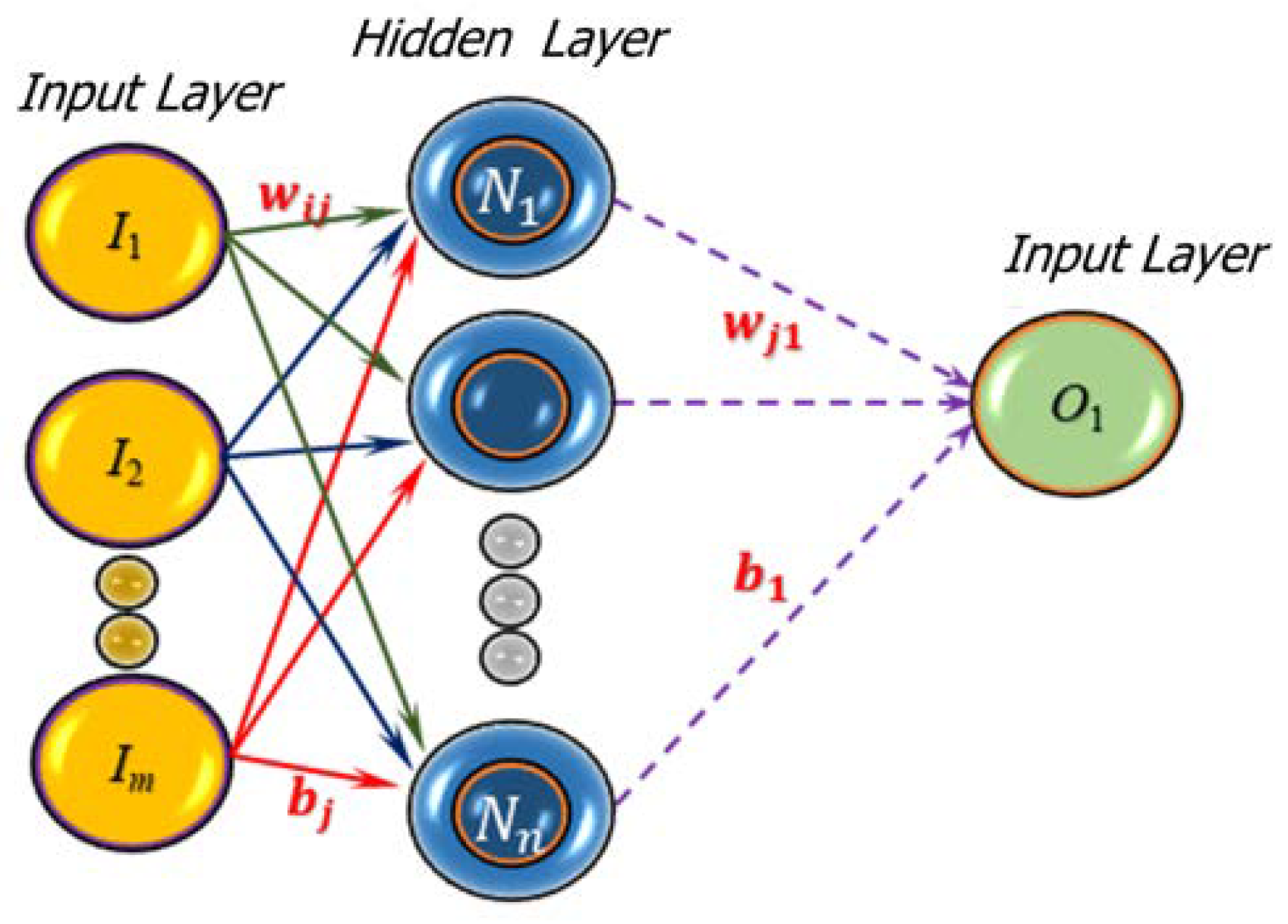

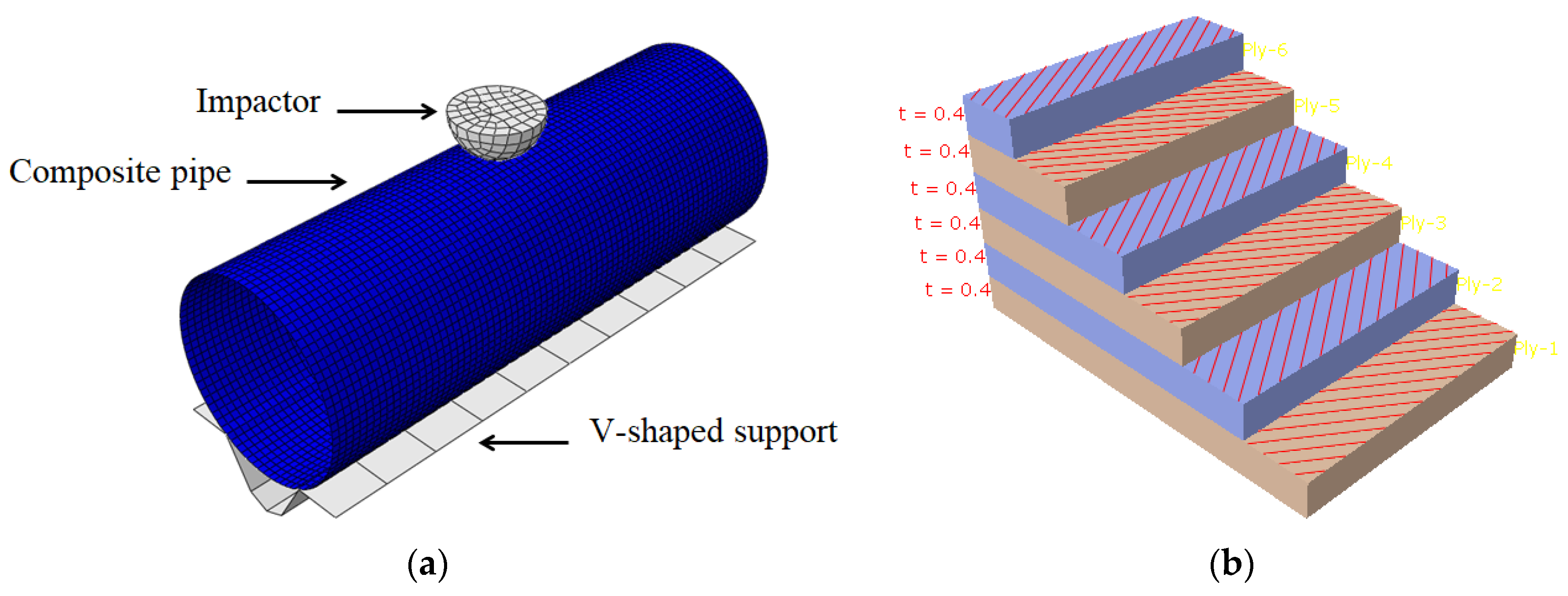

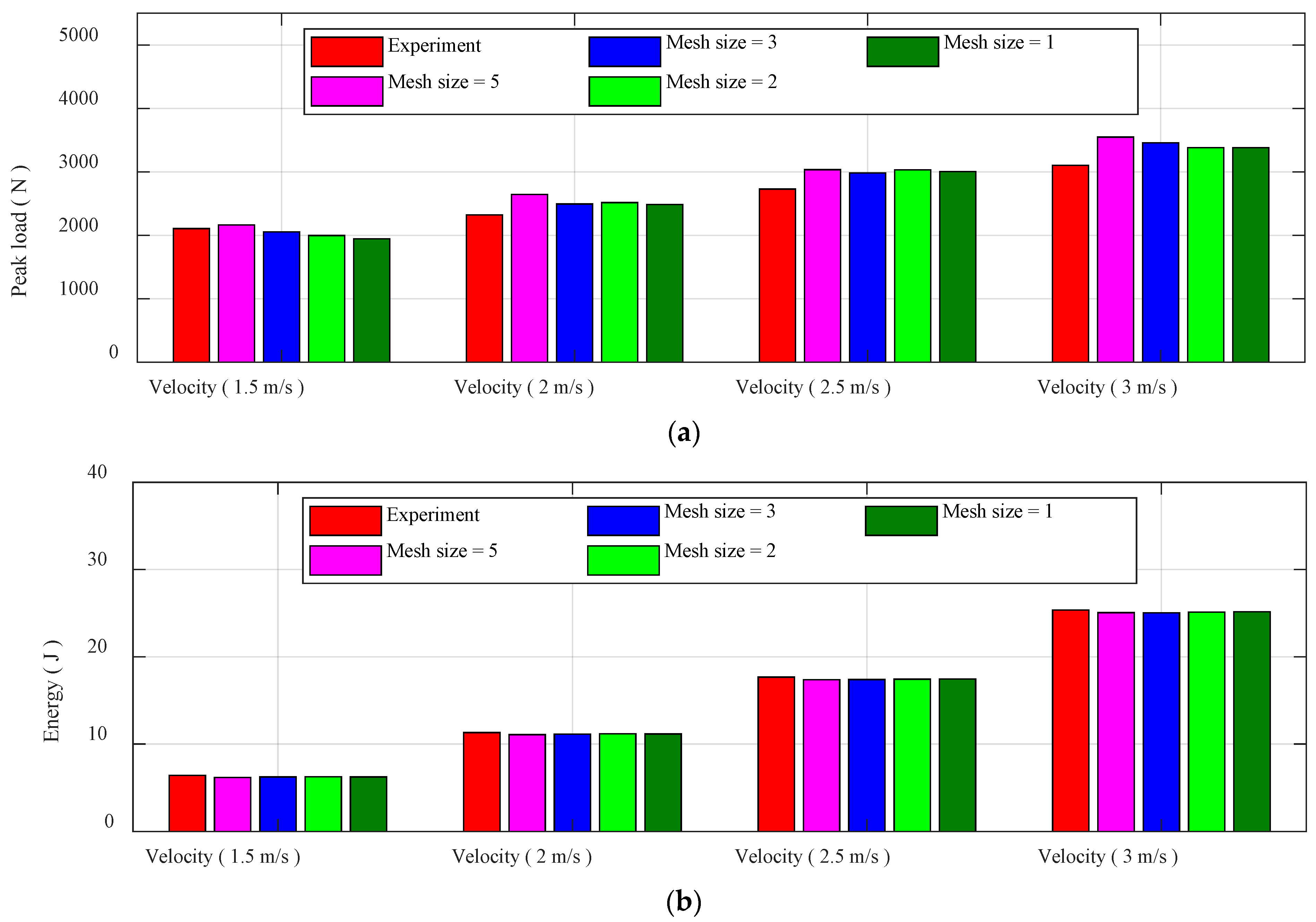
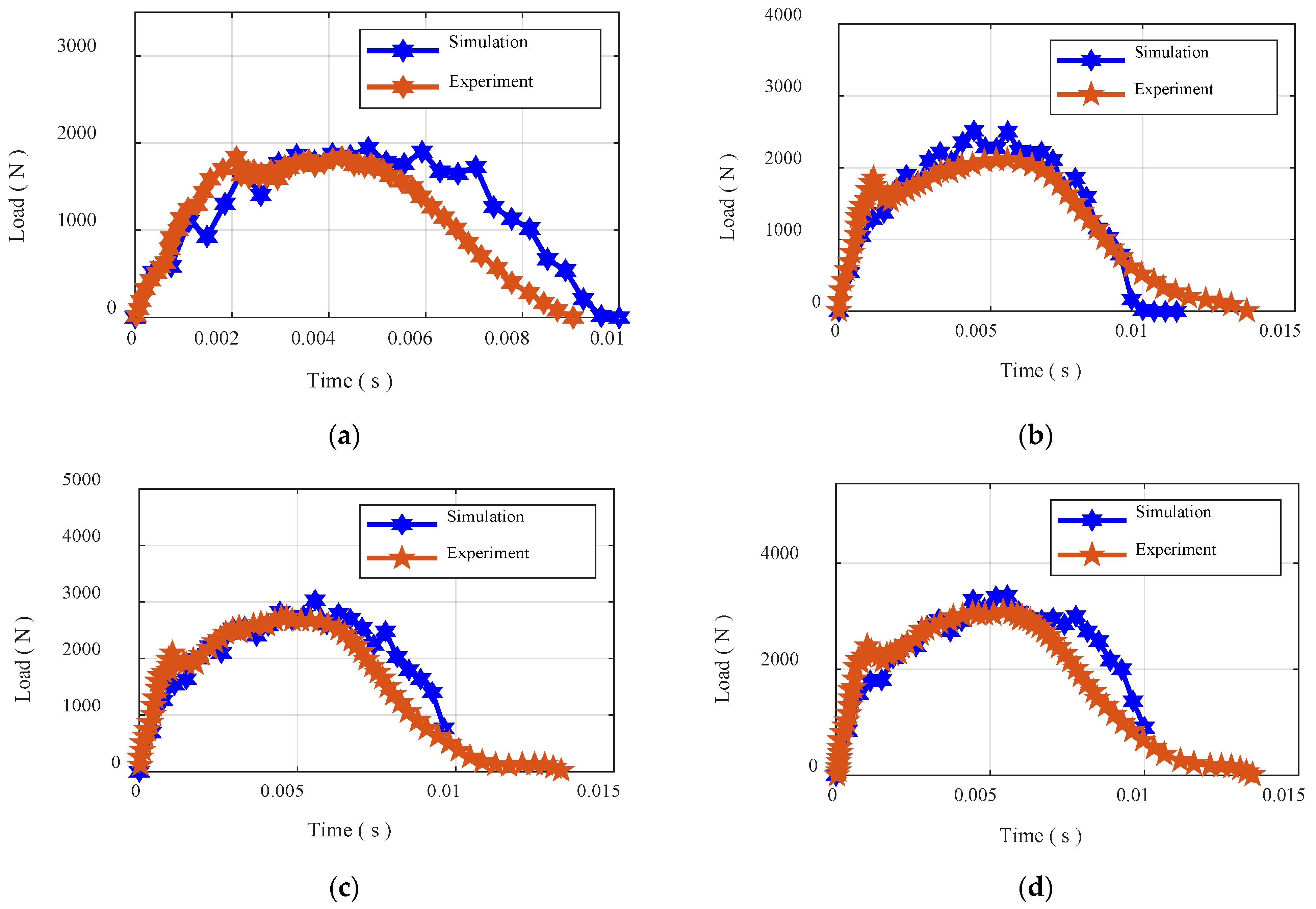
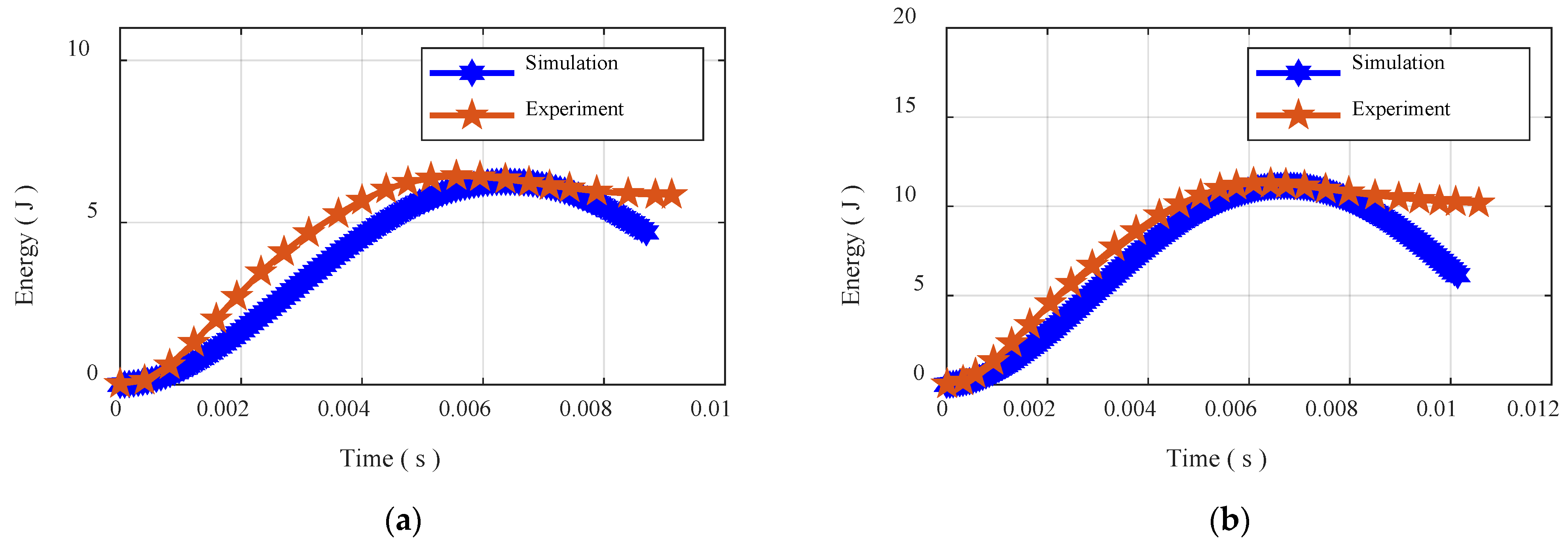



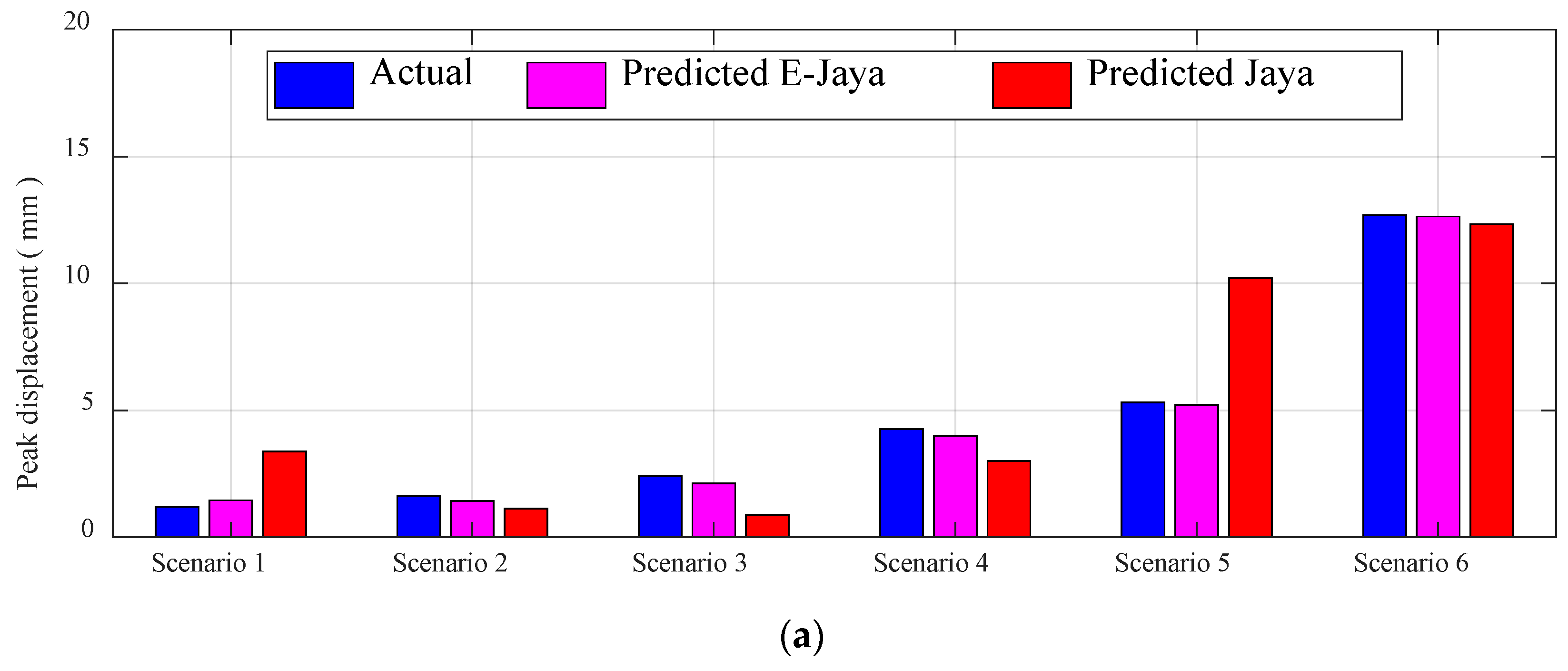
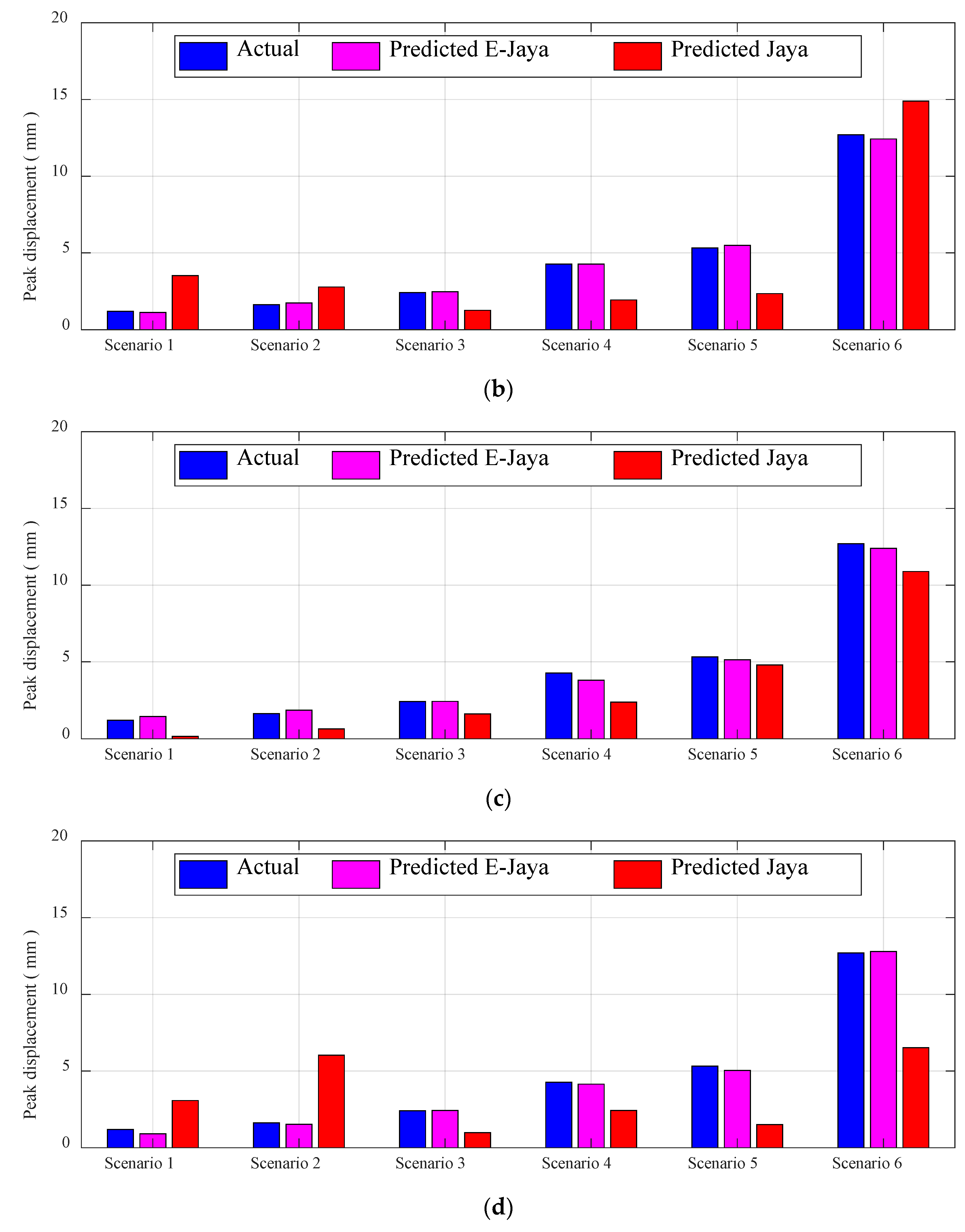
| Composite Pipe | Impactor | ||
|---|---|---|---|
| Length | 155 (mm) | Radius | 12 (mm) |
| Interior diameter | 54 (mm) | Mass | 5.6 (kg) |
| Exterior diameter | 58.8 (mm) | Velocity | 1.5, 2, 2.5 and 3 (m/s) |
| E (GPa) | σtensile (MPa) | ρ (g/cm3) | εfailure (%) | |
|---|---|---|---|---|
| Fiber: E-glass | 73 | 2400 | 2.6 | 1.5–2 |
| Matrix: Epoxy resin | 3.4 | 50–60 | 1.2 | 4–6 |
| Inputs | Outputs | ||||||||
|---|---|---|---|---|---|---|---|---|---|
| Velocity (m/s) | Thickness (mm) | Number of Layers | Stacking Sequence | Displacement (mm) | |||||
| Factors | Levels | Factors | Levels | Factors | Levels | Factors | Levels | - | |
| 1.5 | 1 | 1.3 | 1 | 4 | 1 | (±55) | 1 | ||
| 1.95 | 2 | 6 | 2 | ||||||
| 2 | 2 | 2.6 | 3 | 8 | 3 | (±45) | 2 | ||
| 2.5 | 3 | 3.25 | 4 | 10 | 4 | ||||
| 3 | 4 | 3.9 | 5 | 12 | 5 | (±35) | 3 | ||
| Min | Max | Min | Max | Min | Max | - | Min | Max | |
| 1.5 | 3 | 1.3 | 3.9 | 4 | 12 | 0.791289 | 19.906 | ||
| Hidden = 6 V T N S | Actual peak displacement | Simulated peak displacement | Difference (Absolute value) | Simulated peak displacement | Difference | CPU (Jaya) | CPU (E-Jaya) | |||
| (Abaqus) mm | (Jaya) mm | (E-Jaya) mm | ||||||||
| 1.5 | 4.8 | 12 | 3 | 1.1977 | 3.3815 | 2.1838 | 1.4611 | 0.2634 | 3746.557 | 3070.96 |
| 1.5 | 4 | 10 | 3 | 1.6282 | 1.1378 | 0.4904 | 1.4375 | 0.1907 | ||
| 2 | 4 | 10 | 2 | 2.4162 | 0.8834 | 1.5328 | 2.1267 | 0.2895 | ||
| 2.5 | 3.2 | 8 | 2 | 4.2674 | 3.0015 | 1.2659 | 3.9907 | 0.2767 | ||
| 3 | 3.2 | 8 | 2 | 5.3216 | 10.2138 | 4.8922 | 5.2222 | 0.0994 | ||
| 2 | 1.6 | 4 | 1 | 12.6957 | 12.3378 | 0.3579 | 12.6404 | 0.0553 | ||
| (a) H = 6 | ||||||||||
| Hidden = 8 V T N S | Actual peak displacement | Simulated peak displacement | Difference | Simulated peak displacement | Difference | CPU (Jaya) | CPU (E-Jaya) | |||
| (Abaqus) mm | (Jaya) mm | (E-Jaya) mm | ||||||||
| 1.5 | 4.8 | 12 | 3 | 1.1977 | 3.5246 | 2.3269 | 1.1204 | 0.0773 | 3711.569 | 3113.85 |
| 1.5 | 4 | 10 | 3 | 1.6282 | 2.7805 | 1.1523 | 1.7411 | 0.113 | ||
| 2 | 4 | 10 | 2 | 2.4162 | 1.2612 | 1.155 | 2.4716 | 0.0555 | ||
| 2.5 | 3.2 | 8 | 2 | 4.2674 | 1.936 | 2.3314 | 4.278 | 0.0106 | ||
| 3 | 3.2 | 8 | 2 | 5.3216 | 2.35 | 2.9716 | 5.4882 | 0.1666 | ||
| 2 | 1.6 | 4 | 1 | 12.6957 | 14.9022 | 2.2065 | 12.4277 | 0.268 | ||
| (b) H = 8 | ||||||||||
| Hidden = 10 V T N S | Actual peak displacement | Simulated peak displacement | Difference | Simulated peak displacement | Difference | CPU (Jaya) | CPU (E-Jaya) | |||
| (Abaqus) mm | (Jaya) mm | (E-Jaya) mm | ||||||||
| 1.5 | 4.8 | 12 | 3 | 1.1977 | 0.1565 | 1.3542 | 1.4344 | 0.2367 | 3718.516 | 3068.287 |
| 1.5 | 4 | 10 | 3 | 1.6282 | 0.6487 | 0.9795 | 1.8452 | 0.217 | ||
| 2 | 4 | 10 | 2 | 2.4162 | 1.6043 | 0.8119 | 2.4206 | 0.0044 | ||
| 2.5 | 3.2 | 8 | 2 | 4.2674 | 2.379 | 6.6464 | 3.7983 | 0.4691 | ||
| 3 | 3.2 | 8 | 2 | 5.3216 | 4.7983 | 10.1199 | 5.1405 | 0.1811 | ||
| 2 | 1.6 | 4 | 1 | 12.6957 | 10.8877 | 1.808 | 12.4026 | 0.2931 | ||
| (c) H = 10 | ||||||||||
| Hidden = 12 V T N S | Actual peak displacement | Simulated peak displacement | Difference | Simulated peak displacement | Difference | CPU (Jaya) | CPU (E-Jaya) | |||
| (Abaqus) mm | (Jaya) mm | (E-Jaya) mm | ||||||||
| 1.5 | 4.8 | 12 | 3 | 1.1977 | 3.0797 | 1.882 | 0.9108 | 0.2869 | 3741.412 | 3093.343 |
| 1.5 | 4 | 10 | 3 | 1.6282 | 6.0291 | 4.4009 | 1.5353 | 0.0929 | ||
| 2 | 4 | 10 | 2 | 2.4162 | 0.9828 | 3.399 | 2.4353 | 0.0191 | ||
| 2.5 | 3.2 | 8 | 2 | 4.2674 | 2.4248 | 1.8426 | 4.1478 | 0.1196 | ||
| 3 | 3.2 | 8 | 2 | 5.3216 | 1.5051 | 3.8165 | 5.0469 | 0.2747 | ||
| 2 | 1.6 | 4 | 1 | 12.6957 | 6.5249 | 6.1708 | 12.7985 | 0.1028 | ||
| (d) H = 12 | ||||||||||
Disclaimer/Publisher’s Note: The statements, opinions and data contained in all publications are solely those of the individual author(s) and contributor(s) and not of MDPI and/or the editor(s). MDPI and/or the editor(s) disclaim responsibility for any injury to people or property resulting from any ideas, methods, instructions or products referred to in the content. |
© 2023 by the authors. Licensee MDPI, Basel, Switzerland. This article is an open access article distributed under the terms and conditions of the Creative Commons Attribution (CC BY) license (https://creativecommons.org/licenses/by/4.0/).
Share and Cite
Ghandourah, E.; Khatir, S.; Banoqitah, E.M.; Alhawsawi, A.M.; Benaissa, B.; Wahab, M.A. Enhanced ANN Predictive Model for Composite Pipes Subjected to Low-Velocity Impact Loads. Buildings 2023, 13, 973. https://doi.org/10.3390/buildings13040973
Ghandourah E, Khatir S, Banoqitah EM, Alhawsawi AM, Benaissa B, Wahab MA. Enhanced ANN Predictive Model for Composite Pipes Subjected to Low-Velocity Impact Loads. Buildings. 2023; 13(4):973. https://doi.org/10.3390/buildings13040973
Chicago/Turabian StyleGhandourah, Emad, Samir Khatir, Essam Mohammed Banoqitah, Abdulsalam Mohammed Alhawsawi, Brahim Benaissa, and Magd Abdel Wahab. 2023. "Enhanced ANN Predictive Model for Composite Pipes Subjected to Low-Velocity Impact Loads" Buildings 13, no. 4: 973. https://doi.org/10.3390/buildings13040973






